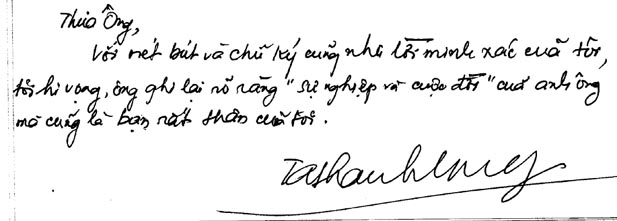
(This letter was sent by Colonel Ta Thanh Long, in which he states that General Hieu died in the evening, rather than at noon time as stated by the 1st Letter. I submit this letter, in all fairness and neutrality, to the consideration of the general public.)
January 4, 1999.
Dear Mr. Nguyen Van Tin,
Pursuant to our phone conversation of January 2, 1999 at 8:00am, I confirm that General Hieu died after the Operations Overview meeting which took place every evening (around 6:30pm) instead of the rumor which has reached you and which stated that General Hieu died at noon time and the report noted in the evening. Here are the facts:
I, as the Head of Vietnamese Delegation, member of the 4-Party and 2-Side Combined Military Committee, had the duty to attend the meeting at the 3 Corps headquarters at 5:00pm every evening to take note and report Communist breaches to the International Committee on Paris Agreement.
That evening, I attended the meeting and General Hieu presided. I was told that General Toan, Commanding General, was busy at the Forward Command Post stationed at Go Dau Ha, Tay Ninh. During the meeting, General Hieu sat in the middle. At his left: General Dao Duy An, chief of Staff and Colonel Phan Huy Luong, Deputy Chief of Staff/Operations. At his right: Mr. Peters, the Consul General of Bien Hoa and I. The back row was occupied by Officers of the General Staff.
After the meeting, General Hieu, General An and I walked into the guest room to have tea. General Hieu told me in General An's presence: "My Pistol Collection has reached the number of 37, I just got a P.38, and had the grooves redone by the Equipment Unit, let me go get it and show it to you." At that point, Colonel Luong stepped in to invite General Hieu to go to supper. General An and I stood up and excused ourselves.
My car took me to Hotel de la Piscine, Bien Hoa (the office of the International Committee), I visited there for about 20 minutes to brief about Communists' breaches with the Colonel Chairman Member. Afterwards, I went home. Upon reaching my office (still in my car), Lieutenant Colonel Nguyen Van Thang, my deputy reported to me: "Colonel Luong needs to see you immediately, General Hieu just died."
I returned to the Corps headquarters and saw Military Police cordoned the headquarters. I asked Colonel Luong: "What happened?" Colonel Luong answered: "After supper, General Hieu went back to his office, a few minutes later a gun shot was heard, guards went in and saw General Hieu covered with blood slumped at his desk, and sounded up the alarm. I invited you to witness so that the proper authority could investigate the cause, because you and General Hieu were classmates and you were the closest to him in this headquarters."
Dear Sir,
With my handwriting and signature, as well as my statement, I hope that you rewrite clearly your "career and life" of your brother who is also a very dear friend of mine.

Comments
1. I take note of time discrepancy in the statements between Colonel Nguyen Khuyen and Colonel Ta Thanh Long: around 12:30pm and around 6:30pm. Who recalled with accuracy, who did not? Their statement should be verified with other witnesses. Colonel Khuyen attended the Anti-Corruption Committee once a month; Colonel Long attended his meeting every evening at 5:00pm; who is more prone in making error in reminiscing?
2. Brigadier General Ly Tong Ba stated that he was in a meeting with General Toan at the 3rd Corps headquarters, and not the Forward Commanding Post at Go Dau Ha as stated by Colonel Long. General Ba said that after the meeting, when he walked by General Hieu's office, he heard a commotion among soldiers mentioning General Hieu was shot in his office.
3. Until now, General Hieu died before going to lunch or supper. This letter states General Hieu died after supper.
4. Until now, General Hieu invited Colonel Luong to go to eat. This letter states Colonel Luong invited General Hieu to go to supper.
5. Until now, the pistol in question had been said to be sent to have the safety device repaired. This letter states that it was sent to have the grooves restored.
6. Colonel Luong was the first to be at the scene when a gun-shot was heard. This letter states guards went in first and sounded up the alarm.
7. Besides, I have obtained the following additional details:
8. In a phone conversation after I had received the above-mentioned letter, Colonel Long admitted: "In all fairness, I have to admit it 's unlikely that a P38 pistol could fire up by itself. In order to fire that pistol, one needs to perform two actions consecutively: 1. release the safety device, and 2. press the trigger."
9. I gladly honor all facts and details pertaining to the mysterious death of General Hieu, with the hope that the review and close examination of these provided facts and details, the truth will be made known.
10. Colonel Long added on January 20, 1999: "In this tragic loss, due to intentional act or to negligence, light will be exposed."
Nguyen Van Tin
24 January 1999
Updated on 08.29.1999